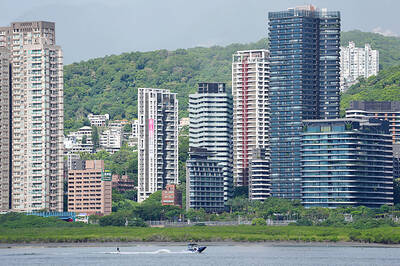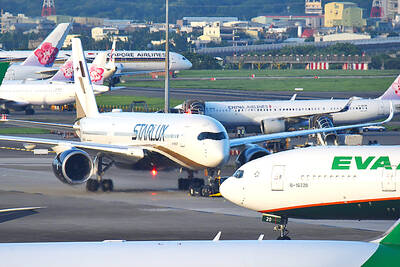Palladium on Friday surged the most intraday since 2008 as scant supply and robust demand extended a record-breaking rally.
Spot palladium jumped as much as 9.7 percent to an all-time high of US$2,539.14 per ounce.
The metal rallied to post its best week since 2001 and has shown little sign of slowing down, even as some analysts caution that prices might be due for a pullback.
Prices were up 8 percent as of 5pm in New York, while futures settled 2.2 percent higher at US$2,224.90.
While palladium’s rally has been driven by supply deficits and surging demand, the increases have exceeded market forecasts, said Noah Capital Markets Ltd analyst Rene Hochreiter, who expects spot prices could retreat to an average of US$2,250 per ounce for the rest of the year.
“Prices do not go up forever and the recent run should see a correction, though the fundamental shortfalls will not go away anytime soon,” Hochreiter said.
Palladium is trading at more than twice the price of platinum, which might motivate automakers to use it as a substitute, Australia & New Zealand Banking Group Ltd (ANZ) said.
“A modest recovery in the auto sector, along with tighter emissions regulations, should lend support,” ANZ strategists Daniel Hynes and Soni Kumari said in a report.
Still, a “price setback is possible for palladium following its impressive rally this year,” they added.
Palladium’s surge has been a boon for platinum group miners in South Africa, which accounts for about 38 percent of global palladium supply.
The FTSE/JSE Africa Platinum Mining Index is at the highest since 2011 and the shares of top producer Sibanye Gold Ltd have risen nearly fourfold in the past 12 months.
“Further weakness in mining production can’t be ruled out,” ING Bank commodities strategists Warren Patterson and Yao Wenyu said in a note to clients. “While higher prices should be encouraging miners to look to boost output, palladium is largely produced as a by-product, making supply more inelastic.”
Supply constraints in South Africa, where producers are grappling with an uncertain electricity system, have been one of the main drivers for the price rally, ABN Amro Bank NV strategist Georgette Boele said.
“It’s a very structurally tight market,” TD Securities analyst Ryan McKay said by telephone from Toronto. “Even the actual physical demand — automakers who use this stuff providing a bid for that metal — that drives the prices up when it’s super tight and supply is not really there.”
In other commodities trading, gold rose US$9.80 to US$1,558.80 per ounce and silver rose US$0.13 to US$18.01 per ounce, while copper was unchanged at US$2.85 per pound.
Additional reporting by AP

RECYCLE: Taiwan would aid manufacturers in refining rare earths from discarded appliances, which would fit the nation’s circular economy goals, minister Kung said Taiwan would work with the US and Japan on a proposed cooperation initiative in response to Beijing’s newly announced rare earth export curbs, Minister of Economic Affairs Kung Ming-hsin (龔明鑫) said yesterday. China last week announced new restrictions requiring companies to obtain export licenses if their products contain more than 0.1 percent of Chinese-origin rare earths by value. US Secretary of the Treasury Scott Bessent on Wednesday responded by saying that Beijing was “unreliable” in its rare earths exports, adding that the US would “neither be commanded, nor controlled” by China, several media outlets reported. Japanese Minister of Finance Katsunobu Kato yesterday also

Taiwan’s rapidly aging population is fueling a sharp increase in homes occupied solely by elderly people, a trend that is reshaping the nation’s housing market and social fabric, real-estate brokers said yesterday. About 850,000 residences were occupied by elderly people in the first quarter, including 655,000 that housed only one resident, the Ministry of the Interior said. The figures have nearly doubled from a decade earlier, Great Home Realty Co (大家房屋) said, as people aged 65 and older now make up 20.8 percent of the population. “The so-called silver tsunami represents more than just a demographic shift — it could fundamentally redefine the

China Airlines Ltd (CAL, 中華航空) said it expects peak season effects in the fourth quarter to continue to boost demand for passenger flights and cargo services, after reporting its second-highest-ever September sales on Monday. The carrier said it posted NT$15.88 billion (US$517 million) in consolidated sales last month, trailing only September last year’s NT$16.01 billion. Last month, CAL generated NT$8.77 billion from its passenger flights and NT$5.37 billion from cargo services, it said. In the first nine months of this year, the carrier posted NT$154.93 billion in cumulative sales, up 2.62 percent from a year earlier, marking the second-highest level for the January-September

‘DRAMATIC AND POSITIVE’: AI growth would be better than it previously forecast and would stay robust even if the Chinese market became inaccessible for customers, it said Taiwan Semiconductor Manufacturing Co (TSMC, 台積電) yesterday raised its full-year revenue growth outlook after posting record profit for last quarter, despite growing market concern about an artificial intelligence (AI) bubble. The company said it expects revenue to expand about 35 percent year-on-year, driven mainly by faster-than-expected demand for leading-edge chips for AI applications. The world’s biggest contract chipmaker in July projected that revenue this year would expand about 30 percent in US dollar terms. The company also slightly hiked its capital expenditure for this year to US$40 billion to US$42 billion, compared with US$38 billion to US$42 billion it set previously. “AI demand actually